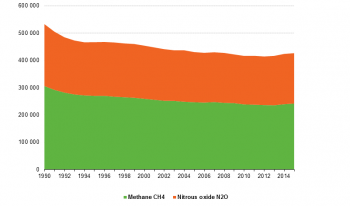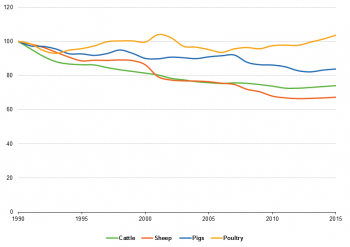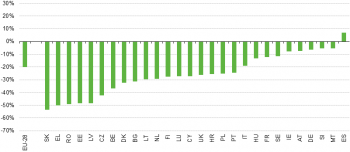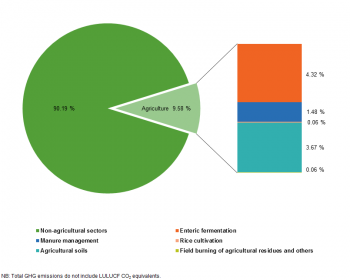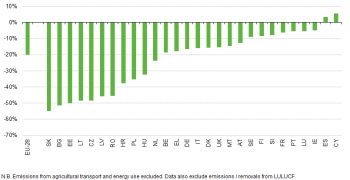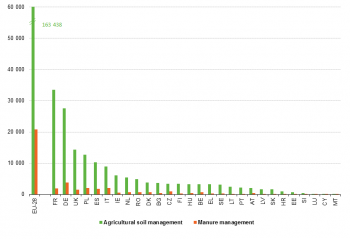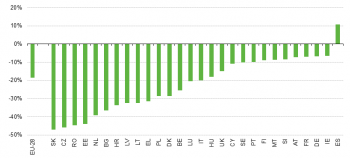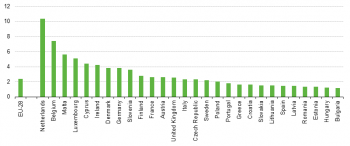Archive:Agri-environmental indicator - greenhouse gas emissions
- Data from September 2017 for the period 1990 - 2015.
This Statistics Explained article is a fact sheet of the European Union (EU) agri-environmental indicator greenhouse gas emissions. It consists of an overview of recent data, complemented by all information on definitions, measurement methods and the context needed to interpret the data correctly. This article is part of a set of similar fact sheets providing a complete picture of the state of the agri-environmental indicators in the EU.
The indicator measures the aggregated annual emissions from agriculture of methane (CH4) and nitrous oxide (N2O). Emissions are shown relative to data for the year 1990 and are expressed as CO2 equivalents.
Main Indicator:
- Greenhouse gas (GHG) emissions from agriculture (kilotonnes of CO2 equivalents per year)
Supporting Indicator:
- Share (%) of agriculture in GHG emissions
Main statistical findings
Key messages
- The agricultural sector produced 426 473 kilotonnes of CO2 equivalent of greenhouse gases in 2015, about 10 % of the EU's total GHG emissions (excluding Land Use, Land Use Change and Forestry (LULUCF) net removals) for that year. GHG emissions from the agricultural sector declined by 20 % between 1990 and 2015.
- The fall in greenhouse gas emissions was due principally to a 17 % decline in nitrous oxide emissions from agricultural soils driven by the reduced use of nitrogenous fertilisers, as well as a 22 % decrease in methane enteric fermentation emissions caused by a reduction in livestock numbers.
Assessment
Total emissions from the EU agricultural sector
The EU's agricultural sector accounted for 10 % of the EU's total GHG emissions (Figure 4) in 2015, producing 426 473 kilotonnes of CO2 equivalent of non-CO2 greenhouse gases (Table 1). The emissions level from agriculture in 2015 was one fifth less than the corresponding level in 1990. Declines were fastest in the period through until 2000, but continued more slowly through until 2012. In each of the last three years of the reference period, however, GHG emission levels rose (Figure 1). The developments in the EU's total GHG emissions from agriculture between 1990 and 2015 closely reflected the composite trends in emissions of methane and nitrous oxide from agriculture (decreases by 21 % and 19 %, respectively - see Figure 1, Figure 7, Figure 9).
The overall reduction in GHG emissions from agriculture during the reference period can in large part be explained by the reduced use of nitrogenous fertilisers (Figure 3), which led to lower nitrous oxide emissions from agricultural soils, and by a reduction in livestock numbers i.e. cattle and sheep (Figure 2), which led to lower methane enteric fermentation emissions (further details can be found in the excel file below).
It is important to note, however, that the EU's emission reductions have been offset, at least in part, by increased production outside the EU. Imports of food and drink into the EU have, for example, increased significantly since 1990.
Although the total decrease in agricultural non-CO2 emissions across the EU-28 was 20 % between 1990 and 2015, individual Member States showed widely varying trends (Figure 5). Based on the official data reported by the Member States, Slovakia (-55 %), Bulgaria (-51 %) and Estonia (-50 %) recorded the largest reductions in relative terms. In contrast, Cyprus (+6 %) and Spain (+4 %) were the only two Member States for which emissions of greenhouse gases from agriculture increased between 1990 and 2015. This is largely explained by expanding livestock numbers, particularly pigs (Cyprus) and cattle, pigs and poultry (Spain).
Methane emissions from the EU agricultural sector
Enteric fermentation of feed in the stomachs of livestock (particularly cattle) is the largest single source of CH4 in the EU-28. Emissions of methane across the EU-28 from agriculture decreased by 64 304 kilotonnes of CO2 equivalents between 1990 and 2015, a reduction of 21 % compared with 1990 levels. Emissions from the two major sources of methane, enteric fermentation and manure management, decreased by 22 % and 17 % respectively over the same period. The main factor behind the absolute reduction in emissions was the reduced numbers of ruminant livestock, particularly in newer EU Member States, with cattle numbers across the EU-28 falling 26 % between 1990 and 2015, and sheep numbers falling 33 %) (Figure 2).
France is the largest emitter of methane from enteric fermentation (Figure 6), accounting for 18 % of all EU-28 emissions of CH4 from this source in 2015. Germany and the United Kingdom were the other main emitters, each accounting for about 13 %. Differences between countries are generally due to types of livestock and their numbers as well as factors such as climatic and stock feed differences.
Across the EU-28, almost all Member States reduced their emissions of CH4 from agriculture between 1990 and 2015. In relative terms, Bulgaria (-70 %) and Slovakia (-64 %) had the largest percentage decreases during this period (Figure 7). Cyprus (+17 %), Spain (+7 %) and Luxembourg (+2 %) were the only Member States that reported increased methane emissions during this period. The larger increases in methane emissions observed in Cyprus and Spain were at least partially associated with higher ruminant animal numbers (cattle and/or swine, respectively).
Nitrous oxide emissions from the agricultural sector
Nitrous oxide emissions from agricultural soils are the largest source of N2O in the EU-28. Emissions of N2O from this source decreased by 17 % between 1990 and 2015, largely due to a general lower use of nitrogen fertiliser on farmland in the majority of Member States during this period (Figure 3).
Emissions of nitrous oxide from agriculture were highest in France and Germany (Figure 8) in 2015, accounting for 19 % and 17 % respectively of the EU-28 total. During the reference period of 1990 to 2015, there were declines in the total N2O emissions from the agricultural sector in all Member States (Figure 9) with the exception of Spain (+11 %). In a number of Member States these reductions were considerable, the steepest rates of decline being in Slovakia (-47 %), the Czech Republic (-46 %), Romania (-45 %) and Estonia (-44 %).
Changes in agricultural practices in a number of Member States have led to relative differences in the amount of N2O emitted. However, it is necessary to interpret trends of N2O emissions in the Member States with care as a number of countries have methodological problems with estimating N2O emissions from agricultural soils.
Greenhouse gas emissions per utilised agricultural area (UAA)
Figure 10 shows the aggregated emissions of CH4 and N2O expressed per hectare of utilised agricultural area (UAA). This analysis provides one measure of the intensity of agricultural activity within a country, and illustrates how the varying land use and agricultural practices across the EU-28 result in variations in emissions intensity. Among Member States, the Netherlands, Belgium, Malta, and Luxembourg had the highest emissions per hectare of UAA, at least twice that of the EU-28 average. This reflects the higher levels of intensification of agricultural activities within these countries.
Data sources and availability
Indicator definition
Aggregated annual emissions from agriculture of methane (CH4) and carbon dioxide (N2O). Emissions are shown relative to data for the year 1990 and are expressed as CO2 equivalents.
Measurements
Main indicator:
- GHG emissions from agriculture (kilotonnes of CO2 equivalents per year)
Supporting indicator:
- Share (%) of agriculture in GHG emissions
Links with other indicators
This indicator has links to a number of other AEI indicators that describe developments in some of the main contributory factors that affect emissions of greenhouse gases from the agricultural sector.
Data used and methodology
Emissions data used in this indicator is from the official national total and sectorial greenhouse gas emissions data submissions reported annually by Member States to United Nations Framework Convention on Climate Change (UNFCCC), EU Greenhouse Gas Monitoring Mechanism and EEA European Environment Information and Observation Network (EIONET). For the EU, the data are compiled by the EEA in the report (and related database) “European Union Greenhouse Gas Inventory 1990-2015 and Inventory Report 2017”. The supporting livestock and fertiliser use data are also from the 2017 annual official national greenhouse gas data submissions under the EU Greenhouse Gas Monitoring Mechanism and EEA/EIONET. Utilised agricultural area (UAA) data are from Eurostat annual crop statistics. Recommended default methodologies for emission data collection are compiled in the IPCC Guidelines for National Greenhouse Gas Inventories.
Each country estimates GHG emissions based on volume of activities (e.g. livestock numbers, agricultural practices) and associated emission factors. The annual aggregated emissions of CH4 and N2O are weighted using their respective 100-year Global Warming Potential (GWP) coefficients (25 for CH4, 298 for N2O). Data are expressed in kilotonnes CO2 equivalent. Carbon dioxide emissions do not include emissions from fossil fuel combustion sources that arise from agricultural-related processes such as transport, greenhouse heating and grain drying. Such sources are inventoried in Intergovernmental Panel on Climate Change (IPCC) under the Energy section, but the individual contribution of agriculture is not inventoried. Under the agreed international guidelines for estimating emissions of greenhouse gases, countries are encouraged to use country-specific methods wherever possible as this leads to improved emission estimates. The different methods used by countries can sometimes mean that data are not fully comparable between countries. Care should therefore be taken when analysing the trends between countries.
Context
Sustainable development and the integration of environmental considerations into European Commission policy instruments are long-term objectives for the EU, as expressed for example in the 7th Environmental Action Programme and the EU Sustainable Development Strategy. In recent years there has been a growing awareness of the need to consider the concepts of sustainable development with respect to agricultural processes, a number of which can have a damaging effect on the environment.
The ‘greenhouse effect’ is the term commonly used to describe the natural process through which atmosphere gases absorb and re-radiate infrared radiation from the earth’s surface, and which is largely responsible for life on earth. It is generally accepted that human activities are altering the composition of gases in the atmosphere, which could cause heat that would normally be radiated out to be retained.
Like any other economic sector the agriculture sector produces greenhouse gases and is a major source of the non-CO2 greenhouse gases methane and nitrous oxide. Both of these gases are many times more powerful greenhouse gases than CO2. In addition, agriculture can significantly affect GHG balances through emissions and removals of CO2 by soils and biomass and through the emissions of GHG precursors such as ammonia. Furthermore, it can affect radiative forcing through the emission of dust and aerosols or by changing the reflectivity of the land surface.
Policy relevance and context
Internationally, the need to avoid and mitigate the potential consequences of climate change are being addressed through the UNFCCC, but climate change is also an issue of high priority within the EU itself. Under the UNFCCC, industrialised countries that have signed the Doha Amendment to the Kyoto Protocol (the so-called Annex I Parties) have agreed emission reduction targets for a basket of seven greenhouse gases. The EU and its 28 Member States, with Iceland, agree to jointly fulfill the emission reduction commitment for the period 2013-2020. This commitment is in line with the EU energy and climate change legislation package, finalised in 2009, which sets an overall target of a 20 % reduction by 2020 compared to 1990 for the EU-28 Member States. Emissions from sectors not included in the Emissions Trading System (EU ETS) - such as agriculture, transport, housing and waste - will be cut by 10 % overall from 2005 levels under the EU Effort Sharing Decision. By 2020, emissions covered by the Emissions Trading System will be 21 % lower than 2005. In 2009 the EU also pledged to increase its emissions reduction target to 30 % by 2020, on condition that other major emitting countries in the developed and developing world commit to do their fair share under a future global climate agreement.
Under the Paris Agreement, Nationally Determined Contributions (NDCs) have been submitted, whereby the EU and its Member States have committed to reduce emissions in the European Union by at least 40 % by 2030.
Aside from general underlying economic trends, which can affect the level of greenhouse gas emissions, a number of European Commission policy instruments have also indirectly affected emissions from the agriculture sector since 1990. For example, the reforms of the EU Common Agriculture Policy [Glossary:Common agricultural policy (CAP) (CAP)] (aimed at changing the methods in which Member States support their farm sectors) and the implementation of the Nitrates Directive (aimed amongst others at reducing water pollution) have already led to changes in farming practices. These changes include a decrease in the use of nitrogenous fertilisers (resulting in a reduction of nitrous oxide emissions from agricultural soils).
Most EU Member States expect greenhouse gas emission reductions in the future from the agriculture sector. It is expected that these savings will occur through implemented and existing policies, as well as additional regulatory, economic and fiscal measures. In particular regulatory policies and measures are regarded as being important mechanisms through which agricultural greenhouse gas emissions can be reduced. There are important differences between emission reductions achieved through reducing activities (such as reducing heads of livestock) versus reductions achieved through reducing emission intensity of production (i.e. emitting less per unit of production). The latter requires important scientific and technological advances, and also more sophisticated inventory and monitoring systems to quantify and monitor the reductions.
Agri-environmental context
Agriculture contributes to climate change through the release of greenhouse gases into the atmosphere. Agriculture can also contribute to climate change mitigation by reducing greenhouse gas emissions and by sequestering carbon while maintaining food production. However, agriculture is also highly exposed to climate change, as farming activities directly depend on climatic conditions (for more information, please follow this link).
For the purpose of international reporting, the emissions of greenhouse gases from agriculture are categorised into the following sources:
- enteric fermentation (CH4)
- manure management (CH4, N2O)
- rice cultivation (CH4)
- agricultural soil management (CO2 CH4, N2O, but not including CO2 emissions/removals resulting from changes in soil carbon stocks, which are covered under the LULUCF sector)
- prescribed burning of savannahs (CH4, N2O)
- field burning of agricultural residues (CH4, N2O)
Methane emissions
The production of methane is closely related to livestock production. Methane emissions mainly occur from enteric fermentation in ruminant animals (e.g. cattle and sheep) and some non-ruminant animals (e.g. pigs and horses), and from the decomposition of manure under anaerobic conditions. The amount of methane emitted by livestock is estimated from the number of animals and an emissions rate per animal. The emission rates mainly depend on the type of digestive system of the animal, the age, weight and energy consumption of the animal, and the quality and quantity of its feed intake.
Emissions of CH4 from manure are calculated based on the amount of manure produced (from the type and number of animals) and the proportion of manure that decomposes anaerobically (itself dependent on climate and manure management and storage practices). These anaerobic conditions often occur when large numbers of animals are managed in confined areas (e.g. dairy farms, beef feedlots, and pig and poultry farms).
Nitrous oxide emissions
Emissions of nitrous oxide are generated during manure storage when manure nitrogen is converted into nitrous oxide. Nitrogen from inorganic fertilisers, animal waste, sewage sludge applications, biological N-fixation and crop residues can be converted to nitrous oxide in the soil. The category ‘agricultural soils’ mentioned above, includes emissions from manure after spreading on soils, but excludes emissions due to manure handling. These latter emissions are included in the category ‘manure management’.
Land use, land use change and forestry - LULUCF
Emissions to and removals from the atmosphere of CO2 result from changes in soil carbon content in grassland and cropland under agricultural practices, and from the change of land use (conversion of grassland to and from cropland, or to and from other uses). While cropland is a source of CO2 emissions, grassland is, on average, a sink for CO2. Such emissions of CO2 arising from land use, land use change and forestry (LULUCF) sector are not included in this factsheet.
Mitigation strategies
There are a number of possible farm management practices[1] [2] that can potentially reduce emissions of agriculture greenhouse gases below current levels. The measures vary in cost-effectiveness and practicality, but include options such as optimisation of fertiliser application rates, non-fertilised set-aside areas, improved feed conversion efficiency by optimising livestock diets, improved animal productivity and rumen efficiency through use of feed additives and breeding, better control of manure management systems to reduce the extent of anaerobic decomposition, and controlling anaerobic digestion by covering manure and slurry lagoons and capturing the methane given off (to use as biogas). Measures to reduce CO2 emissions from soils or to enhance carbon sequestration include the maintenance of permanent pasture, conservation tillage, appropriate crop rotation and cover crops.
See also
- Agri-environmental indicators (online publication)
- Climate change - driving forces
- Europe 2020 headline indicators
- Greenhouse gas emissions by industries and households
Further Eurostat information
Publications
- Agriculture, forestry and fishery statistics — 2016 edition
Database
- Agriculture and environment (aei), see:
- Greenhouse gas emissions from agriculture (data source: EEA) (aei_pr_ghg)
- Agri-environmental indicators (tai), see:
- Greenhouse gas emissions from agriculture (% of total emissions) (tai08)
Dedicated section
Source data for tables and figures (MS Excel)
Other information
- Commission Communication COM(2006)508 final - Development of agri-environmental indicators for monitoring the integration of environmental concerns into the common agricultural policy
- Agri-Environmental Indicators, see:
External links
- Database:
- Methodology
- Other external links:
- European Environment Agency

